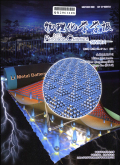物理化学学报2024,Vol.40Issue(7):54-57,4.DOI:10.3866/PKU.WHXB202306041
构筑Bi纳米粒子负载BiOCl纳米片欧姆结用于光催化CO2还原
Construction of Bi Nanoparticles Loaded BiOCl Nanosheets Ohmic Junction for Photocatalytic CO2 Reduction
摘要
Abstract
The continuous increase in the consumption of coal,oil,and natural gas has not only led to the depletion of unsustainable energy sources,but has also caused excessive CO2 emissions,thus resulting in serious energy crises and climate issues.In such a scenario,it is imperative to explore clean and sustainable energy conversion technologies to address the escalating energy demands and environmental crises.Photocatalytic CO2 conversion,inspired by natural photosynthesis,utilizes solar energy to convert CO2 and water into valuable chemicals.After decades of development,artificial photosynthesis has emerged as a green,cost-effective,and sustainable approach to achieving carbon neutrality.However,the challenges of low carrier separation efficiency and insufficient active sites in photocatalysts remain significant hurdles in achieving high-performance CO2 photoreduction.To address this challenge,the integration of metal nanoparticles with semiconductors to create an Ohmic junction can enhance electron-hole migration by the assist of interfacial electric field(IEF).In this study,an Ohmic junction photocatalyst is constructed by in situ formation of Bi nanoparticles on the surface of BiOCl nanosheets through a solvothermal process.The composition and morphology of the photocatalysts were analyzed using X-ray diffraction(XRD),X-ray photoelectron spectroscopy(XPS),and transmission electron microscopy(TEM).UV-Vis diffuse reflectance spectroscopy(UV-Vis DRS)was employed to assess the light absorption performance of the photocatalyst.Transient photocurrent response,electrochemical impedance spectroscopy(EIS),and electron spin resonance(ESR)were utilized to evaluate the efficiency of electron-hole transfer.The distinct work function difference between Bi nanoparticles and BiOCl nanosheets leads to favorable charge transfer characteristics within the formed Ohmic junction,significantly improving the utilization efficiency of photogenerated carriers.Besides,the Bi nanoparticles serve as co-catalysts,enhancing the activation of inert CO2.As a result,the optimized Bi/BiOCl composite(Bi/BiOCl-2)exhibits enhanced generation rates of CO(34.31 µmol∙g-1)and CH4(1.57 µmol g-1)during 4-h of irradiation,which is 2.55 and 4.76 times compared to pristine BiOCl nanosheets,respectively.Isotope tracer experiments suggest that the obtained carbon-based products are generated through CO2 photoreduction in the presence of water molecule under irradiation.Moreover,in situ Fourier-transform infrared spectroscopy(in situ FTIR)results indicate the formation of *CHO,*CH3O,b-CO32-,m-CO32-,HCO-3,HCOOH,*COOH,and HCOO-species during the CO2 reduction process and a possible mechanism for CO2 photoreduction into CO and CH4 is proposed based on these findings.After 25-h of CO2 photoreduction reaction,the yields of CO and CH4 continue to increase.Furthermore,the stability of the prepared material is confirmed by XRD pattern,XPS analysis,and TEM image.These outcomes underscore an effective strategy for constructing advanced photocatalysts tailored for high-performance solar-driven CO2 reduction.关键词
BiOCl纳米片/Bi纳米粒子/CO2光还原/欧姆结/电子传输Key words
BiOCl nanosheet/Bi nanoparticle/CO2 photoreduction/Ohmic junction/Charge transfer分类
化学引用本文复制引用
刘高鹏,李华明,李利娜,王彬,单宁杰,董金涛,季梦夏,朱文帅,朱剑豪,夏杰祥..构筑Bi纳米粒子负载BiOCl纳米片欧姆结用于光催化CO2还原[J].物理化学学报,2024,40(7):54-57,4.基金项目
The project was supported by the China Postdoctoral Science Foundation(2022M721380,2020M680065),Jiangsu Funding Program for Excellent Postdoctoral Talent(2023ZB214),National Natural Science Foundation of China(22108106,22108108),Hong Kong Scholar Program(XJ2021021),City University of Hong Kong Donation Research Grant(DON-RMG,9229021),City University of Hong Kong Strategic Research Grant(SRG,7005505),and City University of Hong Kong Donation Grant(9220061).中国博士后科学基金(2022M721380,2020M680065),江苏省卓越博士后计划(2023ZB214),国家自然科学基金(22108106,22108108),香江学者计划(XJ2021021),香港城市大学捐赠研究资助(DON-RMG,9229021),香港城市大学战略研究拨款(SRG,7005505)及香港城市大学捐赠基金(9220061)资助 (2022M721380,2020M680065)

